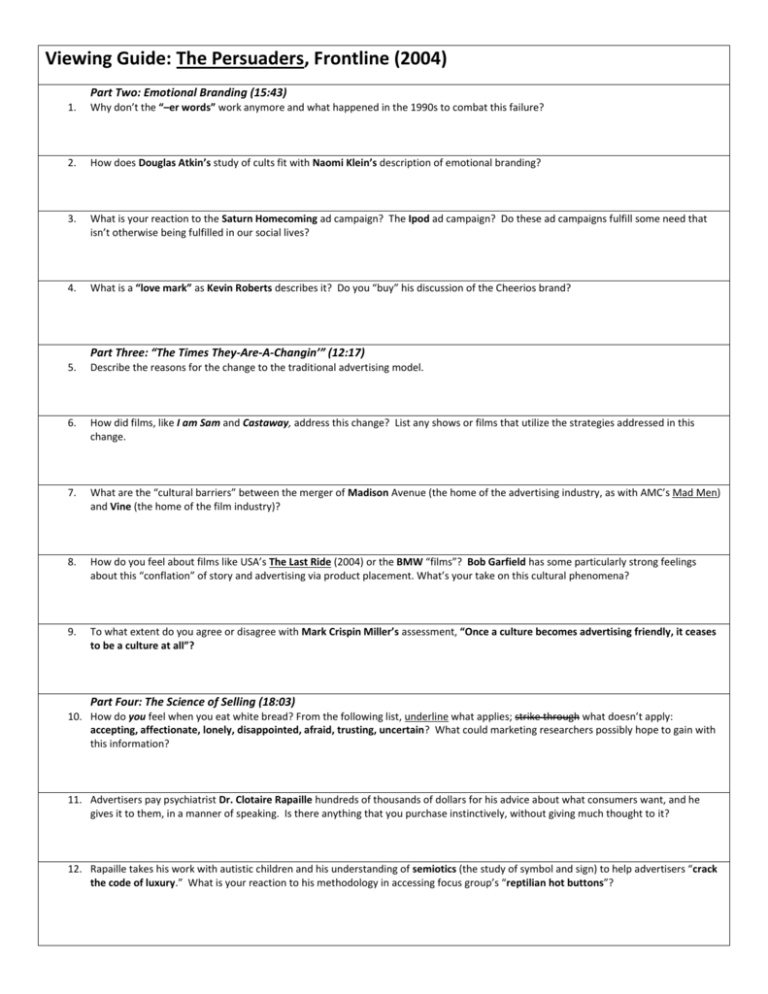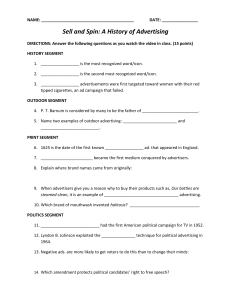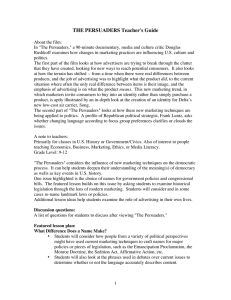File - Cultural Media Literacy
advertisement

Viewing Guide: The Persuaders, Frontline (2004) Part Two: Emotional Branding (15:43) 1. Why don’t the “–er words” work anymore and what happened in the 1990s to combat this failure? 2. How does Douglas Atkin’s study of cults fit with Naomi Klein’s description of emotional branding? 3. What is your reaction to the Saturn Homecoming ad campaign? The Ipod ad campaign? Do these ad campaigns fulfill some need that isn’t otherwise being fulfilled in our social lives? 4. What is a “love mark” as Kevin Roberts describes it? Do you “buy” his discussion of the Cheerios brand? Part Three: “The Times They-Are-A-Changin’” (12:17) 5. Describe the reasons for the change to the traditional advertising model. 6. How did films, like I am Sam and Castaway, address this change? List any shows or films that utilize the strategies addressed in this change. 7. What are the “cultural barriers” between the merger of Madison Avenue (the home of the advertising industry, as with AMC’s Mad Men) and Vine (the home of the film industry)? 8. How do you feel about films like USA’s The Last Ride (2004) or the BMW “films”? Bob Garfield has some particularly strong feelings about this “conflation” of story and advertising via product placement. What’s your take on this cultural phenomena? 9. To what extent do you agree or disagree with Mark Crispin Miller’s assessment, “Once a culture becomes advertising friendly, it ceases to be a culture at all”? Part Four: The Science of Selling (18:03) 10. How do you feel when you eat white bread? From the following list, underline what applies; strike through what doesn’t apply: accepting, affectionate, lonely, disappointed, afraid, trusting, uncertain? What could marketing researchers possibly hope to gain with this information? 11. Advertisers pay psychiatrist Dr. Clotaire Rapaille hundreds of thousands of dollars for his advice about what consumers want, and he gives it to them, in a manner of speaking. Is there anything that you purchase instinctively, without giving much thought to it? 12. Rapaille takes his work with autistic children and his understanding of semiotics (the study of symbol and sign) to help advertisers “crack the code of luxury.” What is your reaction to his methodology in accessing focus group’s “reptilian hot buttons”? 13. How is Rapaille’s example of the “off code” marketing of French cheese to American’s instructive in respect to how cheese is actually marketed to an American audience? Part Five: Giving Us What We Want (13:02) 14. How has Frank Luntz taken the ideas of advertising and applied them to politics? 15. How does Luntz use rhetoric to shape the way we perceive certain corporations or political ideas? What are some famous examples of Luntz’s successes? 16. Does Luntz’s language “help the public see the issue more clearly or do [the words] disguise it?” Should we “merchandise” ideas, political or otherwise? Consider the “estate” tax versus the “death” tax example, or the shift from “global warming” to “climate change.” 17. Is Bob Garfield’s reaction to the “corrosive” influence of advertising in politics on the mark or too hyperbolic? 18. What is “narrowcasting”? Consider the efforts of ACT in Ohio.



